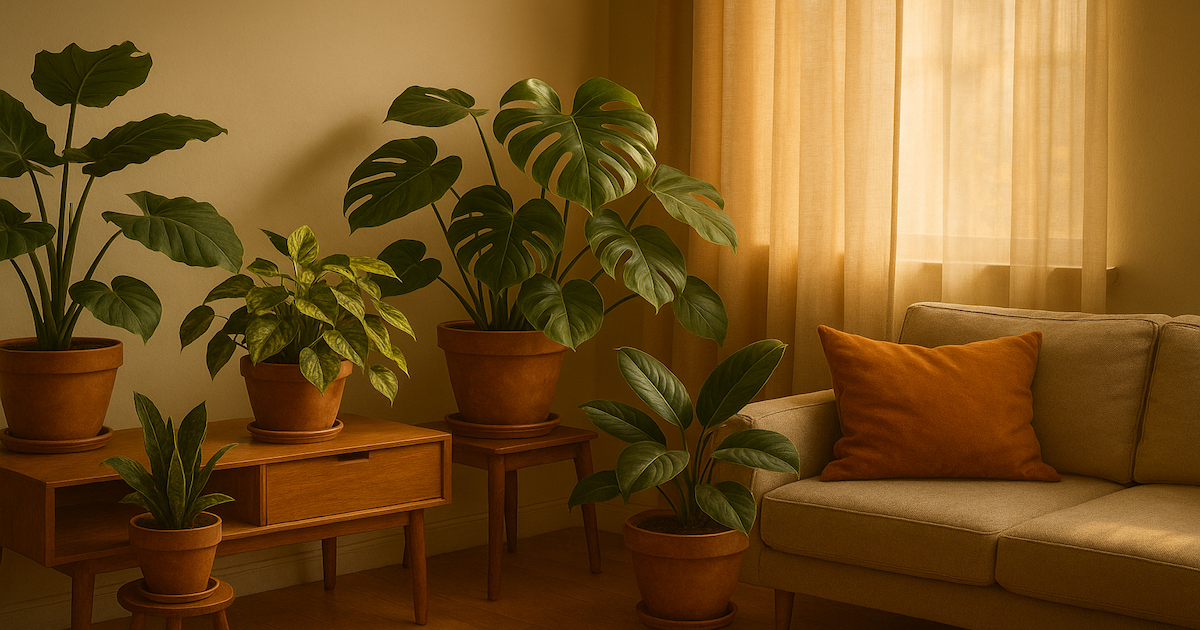Contents
Practicing Forest Bathing at Home with Houseplants
In a perfect world, we’d all wander misty cedar groves every morning. But when life keeps you indoors, houseplants can help bring the forest to you. Shinrin-yoku, or forest bathing, is a Japanese practice that emphasizes quiet immersion in nature to soothe the nervous system and restore wellbeing.
While nothing replaces a walk in the woods, you can still tap into those healing principles—right from your living room.
Understanding Forest Bathing Principles
Forest bathing isn’t exercise or plant care, it’s about presence. The key elements are slow movement, sensory awareness, and a non-judgmental mindset. You’re not trying to “do” anything. You’re noticing. Letting your body and senses lead, not your thoughts.
The therapeutic benefits come from this shift in attention. Studies link forest bathing to reduced cortisol, improved mood, and lower blood pressure.
The good news? Much of that comes from sensory engagement with living green things, not from being miles from civilization. Which is where your plants come in.
Guided Mindful Walk Around Your Plants
Try this: take 10 minutes to meander slowly around your indoor space, treating your houseplants as if they were trees on a trail. Stop at each one.
Look closely at the shape of the leaves, the textures of the stems, the shadows they cast on the wall. Let your breath slow. No need to narrate or analyze. Just be with them.
Walk slowly. Sit if you like. Let your body move how it wants, this isn’t yoga, but it is about embodied presence. If your mind wanders, gently return to what you can see, smell, or feel in that moment.
Sensory Engagement (Touch, Smell, Sight)
Here’s where it gets real: forest bathing is not about what you think about a plant—it’s about what you experience through your senses.
- Touch: Run your fingertips along a leaf. Feel the cool smoothness of a monstera or the fuzz of a kalanchoe.
- Smell: Bring your nose close. Some houseplants like eucalyptus or rosemary have potent scents. Even soil has a grounding, earthy smell.
- Sight: Observe the patterns in a leaf’s veins. Watch how sunlight hits a cactus spine or highlights the translucent edges of a peace lily.
It doesn’t have to be dramatic. Sensory shifts, even subtle ones, are what calm the nervous system. You’re not trying to get somewhere—you’re letting yourself arrive.
Sample 10-Minute Houseplant Forest Bathing at Home Routine
Here’s a simple flow to try. Set a timer for 10 minutes. No music, no podcasts, no phone.
- Start seated – Sit near your plants. Close your eyes. Take 3 slow breaths.
- Open your eyes slowly – Let your gaze settle on the first plant that catches your attention.
- Approach with curiosity – Touch a leaf. Notice its temperature, texture, and flexibility.
- Engage each sense – Smell the soil. Look closely at patterns. Feel the pot’s surface.
- Move slowly to another plant – Notice how your attention shifts.
- End with stillness – Sit with your favorite plant and simply be with it, like an old friend.
This isn’t a checklist. It’s an invitation. Use it as a guide, then ignore it if something else feels more honest.
Tracking Your Stress and Mood Improvements
If you’re curious whether this practice actually helps, track your experience. You don’t need anything fancy.
- Before and after check-ins: Rate your stress or mood 1–10 before and after your session.
- Body cues: Note changes in breath, muscle tension, or energy.
- Journal briefly: One or two lines. “Felt less rushed.” “Surprised by how good that basil smelled.” That’s enough.
Over time, you may start to notice patterns, like how just five minutes with your pothos helps reset your day. That’s your nervous system remembering how to come home.


1 thought on “How to Practice Forest Bathing at Home with Houseplants”
Comments are closed.